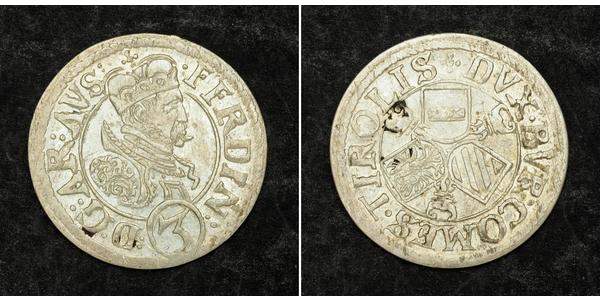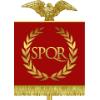(sold for $51.0)
1595, Archduke Ferdinand II of Austria. Silver 3 Kreuzer Coin. Hall mint!
Mint Place: Hall (Tyrol). Mint Period: 1564-1595 State: Holy Roman Empire Denomination: 3 Kreuzer (Groschen) Condition: Minor deposits, otherwise a nice XF-AU! Reference: Hahn:15a var., M-T:242 var., KM-. Scarce! Diameter: 22mm Weight: 2.09gm Material: Silver
Obverse: Crowned and armored bust of Archduke Ferdinand II of Austria right. Legend: . FERDIN : (3) :D:G:AR:AVS. Reverse: Three shields (with arms of Habsburg/Tyrol/Burgundy) separated by sparkling fire-irons (symbol of the House of Habsburg) within inner circle. Legend: * DVX . BVR : COMES . TIROLIS
em>.
Ferdinand II, Archduke of Further Austria (Linz, June 14, 1529 – January 24, 1595) was ruler of Further Austria including Tirol.
Archduke Ferdinand of Austria was the second son of Ferdinand I, Holy Roman Emperor and Anna of Bohemia and Hungary. He was a younger brother of Emperor Maximilian II. At the behest of his father, he was put into charge of the administration of Bohemia in 1547. Also, he led the campaign against the Turks in Hungary in 1556.
In 1557, he was secretly married to Philippine Welser, daughter of a patrician from Augsburg, with whom he had several children. The marriage was only permitted by Emperor Ferdinand I in 1559 under the condition of secrecy. The children were to receive the name "of Austria" but would only be entitled to inherit if the House of Habsburg would become totally extinct in the male line (Also see: morganatic marriage). The sons born of this marriage received the title Margrave of Burgau, an old Habsburg possession in Further Austria. The younger of the sons, who survived his father, later received princely rank, becoming Fürst zu Burgau.
After his father's death in 1564, Ferdinand received the rulership over Tyrol and other Further Austrian possessions under his father's will. However, he remained as governor of Bohemia in Prague until 1567 following the wishes of his brother Maximilian II.
In his own lands, Ferdinand made sure that the Catholic counterreformation would prevail. Since he was an avid collector of art, the collection of the famous Castle Ambras was started in his time. He had begun to work on it even during his time in Bohemia and subsequently moved it to Tyrol. In particular, the gallery of portraits and the collection of armor were highly expensive, which is why the archduke had incurred a high level of debt. Today, those collections are in the Kunsthistorisches Museum in Vienna.
After the death of Philippine in 1580, he married Anne Catherine, a daughter of William I, Duke of Mantua, in 1582.
Archduke Ferdinand died on January 24, 1595. Since his sons from the first marriage were not entitled to the inheritance, and the second produced only surviving daughters, Tirol was reunified with the other Habsburg lines. His daughter from the Mantuan marriage became the Empress Anna, consort of Emperor Mathias, who received his Further Austrian inheritance.
Karl II of Austria, Margrave of Burgau, morganatic son of Ferdinand II, Archduke of Austria married Sibylle (1557-1627), daughter of William, Duke of Jülich-Berg-Ravensberg-Kleve-Mark (28 July 1516 - 5 January 1592), and Maria, Archduchess of Austria, daughter of Ferdinand I, Holy Roman Emperor.
Only 1$ shipping for each additional item purchased!

|
Posted by:
anonymous 2019-02-14 |
10 Mark Bavaria Gold Otto of Bavaria (1848 – 1916)
group has 7 coins / 7 prices
⇑














